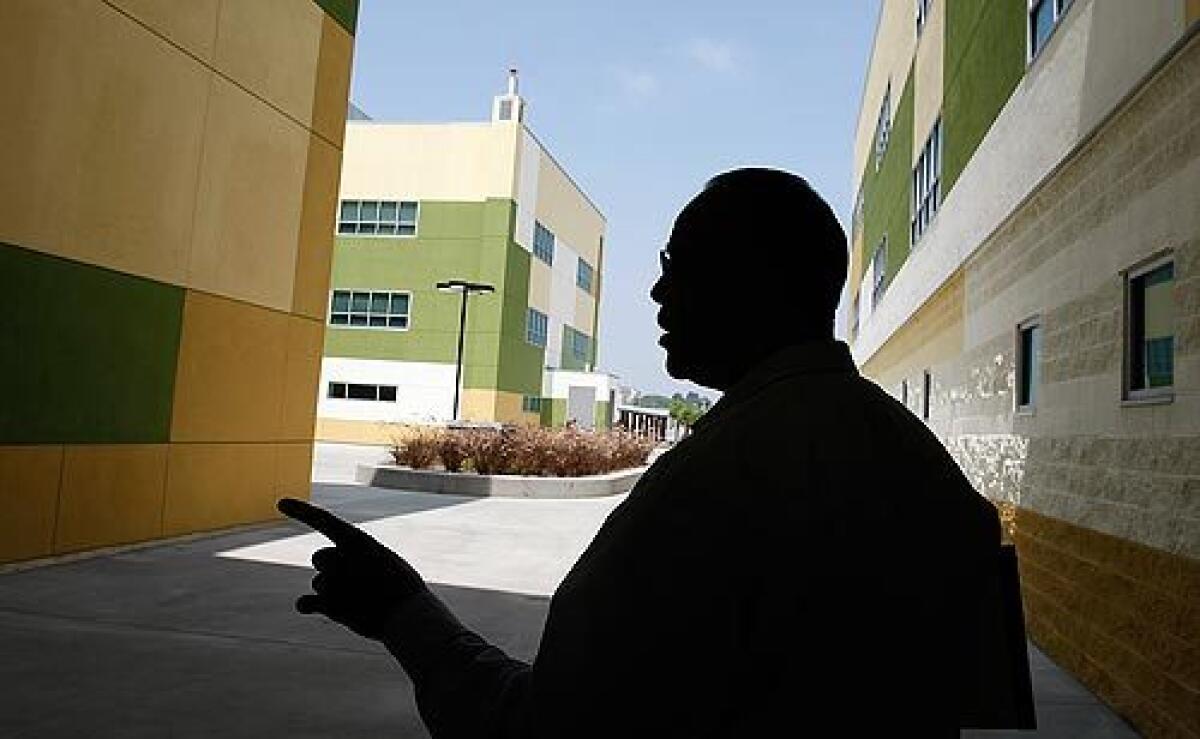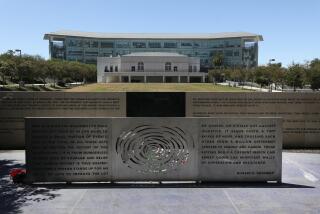New name, new life for Belmont school

Veteran school administrator Scott Braxton could not help but wonder about his new assignment, principal of the school formerly known as the Belmont Learning Complex.
Was this most infamous of schools safe?
“That was the first question I had when I came in for the job interview,” said Braxton, speaking in his office at the soon-to-open Edward R. Roybal Learning Center, the school’s new name.
The more than $400-million school atop an oil field, just west of the 110 Freeway downtown, became notorious not only as an allegedly toxic site but as the nation’s most expensive high school construction project. The furor over Belmont drove out incumbent school board members, a superintendent and a regiment of career administrators. It also led to the rewriting of state law and local policy regarding environmental issues at school sites.
In the process, the Belmont Learning Complex became a symbol of dysfunction for the Los Angeles Unified School District. The construction project led to investigations, commissions, hearings and demonstrations. It was battled over, delayed, canceled, partially demolished and redesigned over 15 years. All the while, thousands of students continued to be bused out of overcrowded neighborhood schools. And Belmont High operated year-round with more than 5,000 students -- their academic year shortened by nearly a month to fit them all in.
“All most people know about Belmont is that it was supposedly so toxic,” said former board member Victoria Castro, who represented the Belmont area. “And that it was very costly. People I meet tell me they thought it was demolished, that it was never going to be.”
Next month, Castro will cheer the school’s opening -- and the return of Belmont High to a traditional, two-semester schedule after 26 years.
And everyone, including Braxton, has been reassured about the campus’ safety. The gas-mitigation system cost more than $17 million to design and install, and will cost $250,000 to $500,000 a year to operate.
A group of current students started meeting at Belmont in this spring to help with the transition. And last week at the sparkling new campus, Braxton and assistant principal Felipe Caceres discussed the potential oil field hazards: methane, which is explosive, and hydrogen sulfide, which is toxic.
“School safety is going to be a concern, the gases and stuff,” said senior Uriel Rivera, 18.
Braxton and Caceres are prepping these students as tour guides for their peers, parents and visitors. So what would people want to know? asked Caceres.
“The names of the things on top of the lights,” offered Christian Ledesma, 16, an incoming junior. He was referring to small, umbrella-like caps atop some poles through which methane vents into the open air.
Overall, the school’s layout situates buildings away from where the most oil drilling occurred. Vapors are probably heaviest there.
In the playing fields, the gases can dissipate harmlessly when they hit the open air. This process is assisted by a layer of sand beneath the turf, which allows vapors to spread out and dilute before rising to the surface.
The buildings -- where gases could potentially accumulate in dangerous concentrations -- are protected by a plastic liner below the concrete slab. And below the liner are tubes to collect gas and carry it outside. Sensors that detect gas will trigger blowers to force it out more quickly. Backup blowers are available if needed. The whole system links to a touch-screen computer in the main office that has a live view of sensor readings, which are recorded in a database.
If the district had to start over, it “might opt to pick another site,” said former district safety director Angelo Bellomo, now the county’s director of environmental health. “Can the school be operated safely? Yes. But it also has to be monitored and maintained for the life of the school without failure. That’s the biggest concern many people have had: that, over time, people would become less concerned and think less about the purpose of the system.”
The concerns at Belmont and other L.A. Unified campuses built over oil fields or polluted ground ultimately led to independent oversight of environmental issues at schools through the state’s Department of Toxic Substances Control. In addition, in L.A. Unified, the safety division no longer reports to facilities administrators intent on holding down costs and keeping projects on schedule.
Roybal Learning Center sits above part of the 800-acre Los Angeles Oil Field, one of many now-developed areas of oil drilling in the L.A. Basin. District experts and consultants said they know of no building -- schools included -- that has more levels of protection than Roybal, which helps explain the high price tag.
Some construction professionals consider the safety system needlessly cautious and expensive, but given Roybal’s history, such an approach became virtually inevitable.
The school board canceled the half-finished project in 2000 over concerns that oil field hazards had not been sufficiently analyzed before construction. By that time, the project had been sullied by conflicts of interest among district staff, consultants and the chosen development team -- resulting, eventually, in the creation of an internal watchdog, the inspector general’s office.
Then-Mayor Richard Riordan used the Belmont scandal as a clarion cry to force out school board incumbents and elect a majority of allies, who quickly pushed out district Supt. Ruben Zacarias. (Riordan later acknowledged that he had no objection to completing the school.)
At the same time, the new and remaining board members, along with Supt. Roy Romer, launched campaigns to pass three bond issues, beginning an intensive $20.5-billion building and modernization program that became the nation’s largest. Along the way, Romer outmaneuvered his own doubting school board to revive Belmont in 2002, after he became convinced that the project was needed, safe and cost effective.
Romer’s Belmont ambitions were temporarily sidelined when geologists discovered an earthquake fault on the property.
The revised blueprint required demolishing any buildings that stood directly over the fault as part of a somewhat smaller campus and a nature park developed with the Santa Monica Mountains Conservancy and other agencies. To sidestep the stigma of the past, officials named the 35-acre park and school Vista Hermosa, or “beautiful view.”
The project’s most consistent and effective opponents included David Koff, a researcher for Local 11 of the Hotel Employees & Restaurant Employees International Union. His digging figured into legislative and law enforcement investigations, although no charges were ever filed. Local 11 originally had entered the fray to put pressure on the Kajima Corp., which opposed unionization efforts at its downtown hotel. Kajima also headed the first Belmont private development team.
“As a project, Belmont was far ahead of the capacity of the district and the quality of the people who were involved in the undertaking,” said Koff, who now works as a filmmaker. “Since that time a lot of projects of a similar scale were undertaken and completed.” On balance, however, “I doubt that the legacy of Belmont could be measured in a positive way that offsets the cost of its history.”
The cost soared one last time because parts of the long-unfinished construction had deteriorated, building codes had become more strict and the new team incorporated upgrades while fixing earlier construction mistakes.
And again the name changed, this time to honor Roybal, the longtime congressman and L.A. councilman who died in 2005.
By L.A. standards, the Roybal campus has impressive amenities for its 2,500 students: a dance studio with a cushioned maple floor the size of a small gym, and a triple gym with seating for 3,000. There are 480 underground parking spaces and 315 trees, as well as outfitted science labs, individual shower stalls in locker rooms, a modern kitchen with a restaurant-quality pizza oven, and planning rooms for teachers in addition to break lounges.
There’s still the matter of choosing Roybal’s mascot.
One student suggested dragons, Braxton recounted. “I was relieved to find the new Helen Bernstein school would be the dragons,” he said. “So, no fire-breathing dragons.”
But he was intrigued by a phoenix, the mythical creature that dies, only to be reborn: “That’s not too bad considering the history of this place.”
Then, he was reminded that during its reincarnation the phoenix bursts into flames.
Braxton rolled his eyes: “I want nothing to do with fire or explosions.”
More to Read
Sign up for Essential California
The most important California stories and recommendations in your inbox every morning.
You may occasionally receive promotional content from the Los Angeles Times.











